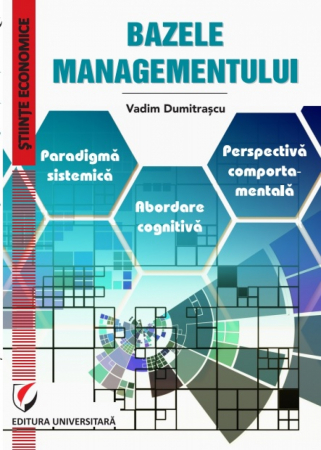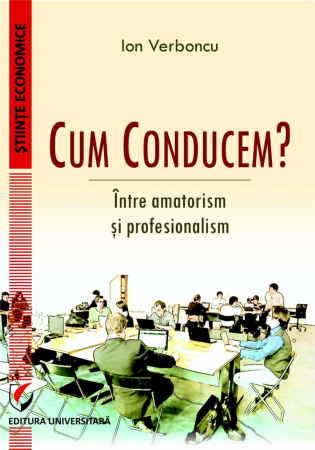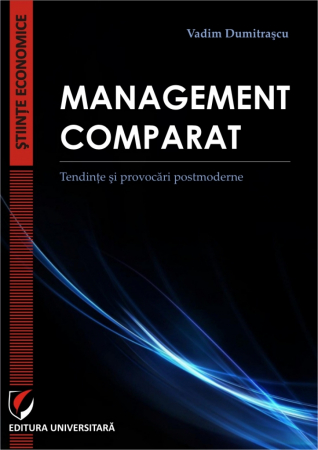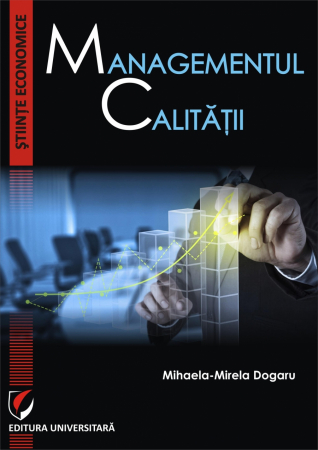6359.png) LEADERS: Archetypes and Organizational Roles. Leadership and Organizational Culture - Vadim Dumitrascu
LEADERS: Archetypes and Organizational Roles. Leadership and Organizational Culture - Vadim Dumitrascu
6359.png)
ISBN: 978-606-28-0430-5
DOI: 10.5682/9786062804305
Publisher year: 2016
Pages: 238
Publisher: Editura Universitară
Author: Vadim Dumitrascu
- Description
- Download (1)
- Authors
- Content
- More details
- Reviews (0)
Although they cannot be accurately identified temporally and spatially, as is the case with events in material reality, the archetypal elements are no less ontologically real. Archetypes are not embodiments of human imagination and fantasy. They have their own and autonomous existence, being at the same time closely related to material reality and human life.
Personalities, behaviors and even people's destinies can be understood and interpreted from the perspective of archetypal principles. Certainly, our daily events and dramas are "profane" stagings of universal mythological themes, the heroes of which are no longer deities or various characters endowed with supernatural powers, but ordinary people. The plays are fundamentally the same, but the actors are different. Old Sheakespeare was right - life is a scene, and we are the actors.
-
LIDERII: ARHETIPURI SI ROLURI ORGANIZATIONALE. Leadership si cultura organizationala
Download
Introduction: archetypes, heroes and leaders / 7
Chapter 1. The issue of leadership in modern organizations / 11
Chapter 2. The archetypes of leadership and the myths of the organization / 25
Chapter 3. The self: the fullness of the soul and the authentic power / 42
Chapter 4. The father: order, law, protection / 62
Chapter 5. Mother: care and compassion / 79
Chapter 6. The wise old man: the counselor and the healer / 99
Chapter 7. The Trickster: improvisation, play, facing uncertainty / 116
Chapter 8. The Magician / Alchemist: Belief and Relational Ability / 133
Chapter 9. The hero: honor and courage / 154
Chapter 10. Development of archetypal resources and organizational roles of leaders / 175
Chapter 11. Organizational development and generic leadership strategies / 183
Chapter 12. "Mathematics" of leadership / 192
Chapter 13. Leadership, management and labor relations in the knowledge-based economy / 199
Chapter 14. The responsibility of power and the "hidden" depths of leadership / 218
Bibliography / 231
Archetypes represent primordial universal configurations that form the collective subconscious or unconscious. There are images that are not limited to the cultural or racial heritage of an individual or human group. They synthesize generating principles that govern the human condition and existence anywhere in time and space. The archetypes express themes, problems, dramas and common expectations for the entire human species, found in all ages and in all peoples. Placing itself beyond the rational and conscious, the archetypal domain manifests itself especially in the form of myths and stories, of folklore in general. Although they appear to us as fantastic narratives, myths describe existential situations characterized by a great load and intensity not only emotional, but also moral or intellectual. In the narrated events and in the characters, real life situations and people can be easily recognized. An old and wise Russian proverb says that "… the fairy tale is a lie, but it contains an allusion to the mental teaching of young people." Myths, as complex archetypal syntheses, are "teachings about life", in which the dramas of existence are purified by details and presented in an absolutized and abstracted form. Mathematics does the same when it solves the mysteries of nature with the help of numbers. Numbers are not simple quantities, but reveal, for those who know how to understand their language, proportions and hidden harmonies. Myths do not operate with numbers, but with archetypes - the psychological equivalent of numbers.
Although they cannot be accurately identified temporally and spatially, as is the case with events in material reality, the archetypal elements are no less ontologically real. Archetypes are not embodiments of human imagination and fantasy. They have their own and autonomous existence, being at the same time closely related to material reality and human life.
Personalities, behaviors and even people's destinies can be understood and interpreted from the perspective of archetypal principles. Certainly, our daily events and dramas are "profane" stagings of universal mythological themes, the heroes of which are no longer deities or various characters endowed with supernatural powers, but ordinary people. The plays are fundamentally the same, but the actors are different. Old Sheakespeare was right - life is a scene, and we are the actors.
Perhaps the most suggestive metaphor for the notion of archetype would be the word "prototype", in the sense of the initial model. The archetype is a "psychological prototype" from which "possible", depending on the genetic heritage and context, all possible human behaviors. It is the primary source from which the human condition is watered in all its hypostases and manifestations. A suitable analogy for archetypes would be DNA. Like DNA, archetypes encode information about the potential psychological reactions of the human species and adjacent behaviors. They are the undifferentiated fullness from which, then, differentiated and individualized variants of human behaviors are separated, under the influence of circumstances. Exactly for this reason, the archetypal domain, that of the collective unconscious is called in some cultural traditions "hall of the gods". And, as it is known, the gods are both good and evil. Not in vain, one of the main archetypal functions is the decanting of the good of evil and the delimitation of the commandments / imperatives of interdictions / taboos. It is obvious, therefore, the universal moral connotation of archetypes. This is best seen in the community of messages conveyed by the great religions of the world and in the very high degree of similarity of the profound teachings that exist between them, despite the huge differences in form. From the mists of time, religions and mythologies whisper the same things to us, in different languages. XXI, as well as on the indigenous populations of Papua New Guinea. You can't get rid of archetypes, like your own shadow. No one can escape the effects of the archetypal domain on behaviors, neither Vladimir Putin, nor Barack Obama, nor His Holiness, nor the fascinated and resourceful inhabitants of Bucharest, nor the worthy and modest Vaslui residents, etc. I mentioned the names of three great global leaders - Putin, Obama and the Pope of Rome. I didn't do it by accident. By this I wanted to emphasize that neither leaders nor leadership in general is an exception to the same inexorable rule: the "destiny" of individuals and groups is encrypted in archetypes.
Every human community, and therefore business organizations, have their own imaginary - the collection of paradigms, concepts, cognitive constructions, ideas, opinions, beliefs, etc., more or less deviated from reality. These creations of the spirit released by the straps of rationality take the form of customs, traditions, rituals or organizational folklore. They and others delimit the field of organizational culture. The modern corporation behaves like a tribe. Just like the papuas, the Eskimos or the Tuareg. It makes no difference. We all belong to the great species of Homo sapiens sapiens. And man is greedy for certainty and security. Thus, when there are few certainties, the void is filled by creations of imagination and fantasy, which often become more "true" than objective, material things. But we must be very careful in labeling these creations, because through them the collective unconscious speaks to us, the archetypal domain. Without explicitly realizing this (hence it is called unconscious or subconscious), archetypal characters, who are nothing but psychological and behavioral patterns or "prototypes of personalities", insinuate the unnoticed into the conscious, guiding them after own laws.
Our rational preferences and choices are nothing but "whispers of the gods." "Mortal Heroes" are projections of "legendary heroes." For organizations, this aspect is essential because the role of leaders - of the heroes in organizations - is difficult to underestimate. As Simon Sinek, the author of the highly successful book on leaders and leadership, rightly believes, leaders eat last: “Leaders are the first to venture into the unknown. They are rushing to danger. They set aside their own interests to protect us or to lead us to the future. Leaders would immediately sacrifice what belongs to them to protect what belongs to us.
And they would not sacrifice what is ours, to save what is theirs. That means being a leader. It means that they choose to face the danger first, advancing towards the unknown. And when we are sure that they will take care of us, we will march behind them and work tirelessly to fulfill their vision and we will proudly call ourselves their followers. "
It is about true, authentic organizational leaders, who gain their power and use it very responsibly, for the good of the whole community. Certainly, there are certain expectations from members of organization leaders. These expectations are a reflection of the concerns, concerns and needs felt by most members of the organization. But they are anchored not only in rational calculations or in the records of everyday life, but they undoubtedly have a determination that draws its strength from the collective imagination and, therefore, from the collective unconscious - in our deepest forums, often without realizing ourselves. thing, especially when we are assailed by the yurts of problems and changes, we hope to appear the Knight on White Horse, the savior, who will save us from the Dragon, from plagues, oppression, villains, injustice.
The truth is that we all, even the most cerebral and lucid, like stories (the fact that many people do not recognize this is a completely different story). We long for the fantastic. The unusual, extraordinary and extraordinary need seems to be one of the fundamental human needs even for today's sophisticated people. This has the following explanation: the characters and actions in the stories reflect ideal people and situations. That is why, defying the millennia, the great stories, myths and religions keep their fresh spell and continue to fascinate us. In fact, the need for the fantastic expresses the need for the ideal, perfect, harmony, justice, fairness, fulfillment. A normal person (without pathological deviations or crippled in soul) wants to triumph over good, to do justice, to defeat the virtuous, to receive according to deeds, to be all happy, healthy and rich, etc. At least in stories, if not in real life. Stories give us what we lack most in real existence. For this reason, the film 300 has higher revenues than Crime and Punishment, just as the Lost Bible sells in huge runs, which we can't say about the Critique of Pure Reason, Lady Gaga's latest music video is incomparably more popular than the Orchestra's latest concert Viennese symphonies, and chaos theory or fractal geometry seem more attractive than multiplication table or classical trigonometry.
The following paper is an interdisciplinary approach, based on concepts borrowed from Jungian psychoanalysis, anthropology, sociology, organizational theory, history of religions, economics, neuroscience, biology, etc. of the phenomenon of modern leadership. Organizations, even economic ones, are first of all human groups within which certain collective phenomena and dynamics develop. Approaching them strictly from an economic perspective would be not only boring, but also incorrect. Financial indicators, so dear to economists, tell us many useful things about the state and prospects of the business organization, but even more are not said or even hidden. As an economist, I admit this with some embarrassment.
The Author

![LEADERS: Archetypes and Organizational Roles. Leadership and Organizational Culture - Vadim Dumitrascu [1] LEADERS: Archetypes and Organizational Roles. Leadership and Organizational Culture - Vadim Dumitrascu [1]](https://gomagcdn.ro/domains/editurauniversitara.ro/files/product/large/liderii-arhetipuri-si-roluri-organizationale-leadership-si-cultura-organizationala-610-910121.jpg)













